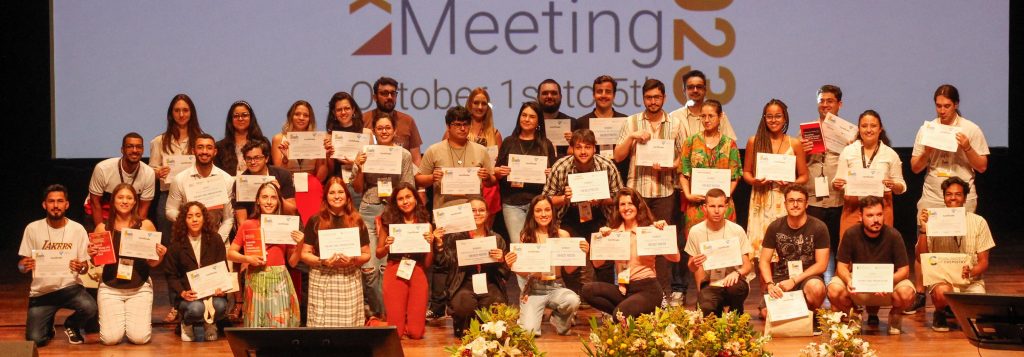Sorry, this entry is only available in Brazilian Portuguese.
Category: News
XXI B-MRS Meeting: symposia overviews
Check out the highlights of some symposiums according to their organizers.
Symposium D: Advanced materials applied in sensors for health, agricultural, and environmental applications.
Our symposium featured the presentation of approximately 130 papers, 28 of which were oral. We had a presentation by 4 invited speakers from Spain, England, Austria, and Brazil. Regarding oral presentations in the form of posters, we had the participation of Brazilian researchers from practically all regions. Thirteen students submitted their work to compete for RCS and ACS awards. Notably, one of the competitors was selected to receive both awards.
In summary, the objectives proposed for this symposium were fully achieved.
Symposium G: Photocatalytic materials applied in energy conversion and environmental remediation.
162 works were presented, 134 works in the form of posters, 23 works in the form of oral presentation and 5 lectures (invited lecture), with the presence of 2 renowned speakers from abroad: Dr. Conchi Ania from the University of Orléans – France and Dr. Andrea Folli from Cardiff University- United Kingdom.
Of the 162 participants in Symposium G, 69 were from the Northeast region, 60 participants from the Southeast region, 19 from the South region, 4 from the North region, 2 participants from the Center-West of Brazil and 8 from abroad. 9 students competed for prizes, being awarded a prize for the presentation in the form of a poster and a prize for the oral presentation.
This Symposium promoted interaction between researchers and students on advances in the development of new nanostructured materials for the conversion and storage of solar energy, mainly photocatalytic materials for solar water splitting for hydrogen production, conversion of CO 2 into fuels and environmental remediation.
Symposium H: New developments in battery materials: designing and producing more efficient systems via nanoscale characterization.
The Symposium H and the workshop of 2023 B-MRS meeting focused on the latest advances and challenges in the field of battery materials and were held successfully.
Both events gathered a good number of participants. The symposium featured 4 high- level invited speakers from Harvard University, University of Lisbon, Wien University and Thermo Fisher Scientific, 5 oral presentations with one from Thermal Fisher Scientific, one from Italy and 3 from different institutions of Brazil and 10 posters.
There were two invited speakers from China and one invited speaker from USA who could not make their trip due to visa issues. There were less participants than we expected, and the main reason might be that there were three similar symposia for energy storage materials. We believe that the research about battery materials would be significantly boosted in the next years due to the discovery of the Lithium ore in Bazil and thus, a battery symposium will attract a larger interest in the future, namely participants from Industry. Another point that we would like to address is the student awards. There were only a few extended abstracts submitted for awards. We visited all the posters and asked why the students did not apply for the award and the answer was lacking courage. In this case, we should really encourage all the students for extended abstract submission. Overall, the symposium and the workshop were successful, and the symposium organizers would like to thank all the speakers, participants, sponsors and reviewers for their contribution to the success of the event.
Symposium R: Organic electronics, photonics and bioelectronics: fundamentals, applications and emerging technologies.
Symposium R on organic electronics, photonics, and sensing applications was an outstanding success, showcasing the vibrant and innovative landscape of research in this field. We were honored to host renowned international researchers who delivered inspiring talks, shedding light on the cutting-edge developments in this area. The impressive talks from Brazilian presenters highlighted the exceptional quality of research carried out in the country, despite the persistent funding cuts we have faced in recent years. Moreover, the contributions from our talented student speakers demonstrated the remarkable potential of the next generation in advancing the field and filled us with hope for the future of research in Brazil. Symposium R was a true demonstration of the collaborative spirit of our community, and we look forward to replicating its success next year in Santos.
Symposium U: Sustainable production of nanomaterials and ink formulations for affordable, efficient, and reusable printed electronics.
The XXI BMRS Symposium U received a total of 25 submissions, of which 8 were oral presentations covering a wide range of topics. These submissions were mainly represented by bright young researchers from Brazil. In terms of invited talks, the symposium was marked by high-level presentations from international researchers, namely Dr Sergio Pinilla from the Madrid Institute for Advanced Studies (IMDEA); Prof. Jeff Kettle from the University of Glasgow; Dr Emanuel Carlos from CENIMAT, Universidade Nova de Lisboa and Dr João Coelho from CENIMAT, Universidade Nova de Lisboa/Facultad de Física, Universidad de Sevilla. These were high-quality presentations that led to a very fruitful discussion session. In fact, in all the presentations, with an audience of around 50 people, there were always interesting questions for the speakers, which raised the scientific level of the symposium. It is also important to mention that Merck also had a representative, Carla Decandio, at the symposium. This participation provided a very interesting overview of how big companies are trying to move towards sustainable chemicals and green-printed electronics.
In terms of awards, the oral presentation “Electrodeposition of manganese oxide on paper-based laser-induced graphene for sustainable supercapacitor fabrication” by PhD student Maykel dos Santos Klem ((FCT-UNESP)) was awarded the Bernhard Gross Prize for Best Symposium Presentation. The best poster award went to Júlia Ketzer Majewski (UFPR).
Overall, the symposium was a success and hopefully an inspiration for all young researchers interested in sustainability and printed electronics.
Symposium V: Advanced nanocomposites for photonics : materials synthesis, optical properties and applications.
The symposium focused on recent developments of photonic nanocomposites: synthesis, characterization and potential technological applications. Overview of recent works and experiments that are still being conducted were presented based on advanced nanocomposites: glasses, glass-ceramics, colloids, two-dimensional materials, photonic crystals, hybrid systems, flexible and nanostructured thin films, quantum dots, among others. Several applications for photonics were highlighted as follows: nanothermometry, color displays, optical amplifiers, photovoltaic devices, magneto-optical sensors and random lasers
Poster sessions occurred (October 2nd to 4th) with 70 presentations; the work about tellurite glasses doped with Er3+ ions with potential for thermometry sensing applications, presented by Gaston Lozano Calderón, from Instituto de Física de São Carlos (São Paulo-Brazil), received the Bernhard Gross Award for poster presentation. Oral sessions took place from October 2nd to 5th with 37 presentations, including 14 invited lectures from Brazil (3), Canada (1), Italy (2), France (2), Mexico (1), Spain (1), and USA (4). João Antonio Oliveira Santos, from Universidade Estadual Paulista Júlio de Mesquita Filho, received the Bernhard Gross Award for the oral presentation about smart nanohybrid platform for temperature sensing. It is important to emphasize the broad audience in all the sessions and the permanent interaction with the presenters. The enthusiasm of the students deserves to be mentioned and motivates all of us to continue persistently.
XXI B-MRS Meeting: Student Awards and Prizes.
Photos: the album of the Student Awards and Prizes Ceremony is available here.
Bernhard Gross Award
(Established by B-MRS in honor of Bernhard Gross, a pioneer of Brazilian materials research. It distinguishes the best oral and poster contributions presented by students in each symposium)
Symposium A – Poster. Cléber Gomes de Jesus. Artificial neural networks applied in the catalytic process of urease and conjugated polymer thin films.
Symposium A – Oral. Tatiane Pretto. Synthesizing double halide perovskites with machine learning prediction.
Symposium B – Poster. Douglas S. Rocha. SiO2/graphene oxide nanocomposite obtained from rice husk pyrolisis.
Symposium C – Poster. William Ottoni Barbosa Azevedo. Preparation and Characterization of PET/PA6 blend composites with sugarcane bagasse ash as a filler and Joncryl as a chain extender.
Symposium C – Oral. Francielle Crocetta Turazz. Polyaniline-silica doped with oxalic acid as a novel extractor phase in thin film solid phase microextraction for determination of hormones in urine.
Symposium D – Poster. Maria Helena Lacerda de Oliveira Fung. Use of an electrolyte-gated transistor to distinguish honey from molasses.
Symposium D – Oral. Andre Oliveira Santos. Agaricus bisporus lectin/poly(methylene blue)-based photoelectrochemical biosensor for selective lactose analysis in foodstuffs.
Symposium E – Poster. Maria Eduarda Colaço Mesquita da Silva. Graphene oxide antibacterial activity for medical devices.
Symposium E – Oral. Isabela Tavares Rampim. Physico-chemical characterization of six commercial chitosan and impact on antibacterial releasing.
Symposium F – Poster. Mariana Gisbert Jardim dos Santos. CO2 reduction reaction during pulsed laser ablation of gold in water for the control of the regenerative properties of carbon monoxide rich gold nanoparticles in endothelial tissues.
Symposium F – Oral. Alessandro Ajó. siRNA controlled release from porous silicon nanoparticles coated with hyaluronic acid.
Symposium G – Poster. Daiane Fernandes. Fast Synthesis of NaNbO3 nanoparticles with high photocatalytic activity.
Symposium G – Oral. Maria Eduarda Ribeiro da Silva. Effect of relative band position between semiconductors in photoanodes dedicated to green hydrogen production: TiO2/CdTe case.
Symposium H – Poster. Rodrigo Lavareda dos Santos. Synthesis and characterization of PVA/PVDF membranes blended with LiOH.
Symposium H – Oral. Juliana Pereira da Silva. Poly(o methoxyaniline) modified by the Biphasic Ceramic System Na2Ti3O7/ Na2Ti6O13.
Symposium I – Poster. Camila Angela Gonzatti. Enzymatic catalyst for valorization of domestic food waste as a renewable feedstock.
Symposium I – Oral. Breno Luiz de Souza. Unveiling the lithium-sulfur batteries: insights from a multidimensional in-situ and operando cell.
Symposium K – Poster. João Pedro Ferreira Assunção. Ti3C2Tx-MXene dopped PMMA passivation layer for highly efficient and stable inverted perovskite solar cell.
Symposium L – Poster. Roberto Turibio Ebina Kawanaka Martins. Study of optically stimulated luminescence properties of amazonite.
Symposium L – Oral. Matheus Cavalcanti dos Santos Nunes. Investigation of the Optically Stimulated Luminescence of Brazilian Alexandrite stimulated with different light sources
Symposium N – Poster. Luana Cristina Miguel Rodrigues. Wear-resistant Fe-Cr-Mo-Nb-B coating by plasma transferred arc.
Symposium N – Oral. Jéssica Bruna Ponsoni. Reversible room temperature hydrogen storage in the (Ti0.5Zr0.5)(Fe0.33Mn0.33Cr0.33)2 multicomponent alloy designed by computational thermodynamic tool.
Symposium O – Poster. Aline da Graça Sampaio. Effect of home-made non-thermal plasma jet on oral mucosal wound healing in rats undergoing chemotherapy treatment: a screening setting.
Symposium P – Poster. Jaqueline F. Rocha. Tuning the chemical and electrochemical properties of carbon paper-based electrodes by pyrolysis of polydopamine nanofilms.
Symposium P – Oral. Bruno Las-Casas Chaves. Fine-tuning cellulose nanofribils for enhanced packing performance via enzyme-assisted defibrilation packing performance via.
Symposium Q – Poster. Brenda Juliet Martins Freitas. Wear and corrosion behavior of a boron-modified duplex stainless steel produced by laser powder bed fusion.
Symposium Q – Oral. Jhonata Rafael Verza. Main parameters and challenges for producing high-quality alumina-based ceramic parts via digital light processing technique.
Symposium R – Poster. Carlos Augusto da Silva Leão. Asymetric Donor-Acceptor molecule exhibiting an efficient Thermally Activated Delayed Fluorescence: Photophysical study.
Symposium R – Oral. Bianca de Andrade Feitosa. Unraveling Fundamentals on Organic Electrochemical Transistors Through Thermodynamics Principles.
Symposium S – Oral. Pedro Henrique de Lara Sanches. Spectroscopic studies of a composite from Eu3+-doped cellulose nanocrystals/fibroin for luminescent cholesteric film production.
Symposium U – Poster. Júlia Ketzer Majewski. Thin Flexible Films Obtained by Slot Die Coating of Water Based P3HT and P3HT:PCBM Nanoparticles.
Symposium U – Oral. Maykel dos Santos Klem. Electrodeposition of manganese oxide on paper-based laser-induced graphene for sustainable supercapacitor fabrication.
Symposium V – Poster. Gaston Lozano Calderón. Optical thermometry of tellurite glasses doped with Er3+-Yb3+ under UV and NIR excitation.
Symposium V – Oral. João Antonio Oliveira Santos. A smart nanoplatform based on upconversion nanoparticles functionalized with europium complexes for temperature sensing
Symposium X – Poster. Frederico Barros de Sousa. Optical Characterization of Vanadium Doped WS2 Monolayers with Room-Temperature Ferromagnetic Ordering.
Symposium X – Oral. Flávio Henrique Feres. Graphene as a gate-tunable window for near-field imaging in the terahertz.
Symposium Y– Poster. Ana Carolina Figueiredo Prado. Microstructural evolution of castable high-alumina ceramics bonded with anionic colloidal silica.
Symposium Z – Oral. Pamela Costa Carvalho. Correlation between interfacial atomic intermixing and the formation of skyrmions.
ACS Publications Prizes
(Sponsored by journals of ACS Publications, a division of the American Chemical Society. Prizes for the best student contributions of all the event)
Symposium B – Poster. Douglas S. Rocha. SiO2/graphene oxide nanocomposite obtained from rice husk pyrolisis.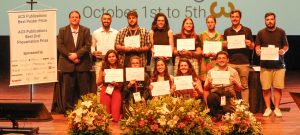
Symposium F – Poster. Mariana Gisbert Jardim dos Santos. CO2 reduction reaction during pulsed laser ablation of gold in water for the control of the regenerative properties of carbon monoxide rich gold nanoparticles in endothelial tissues.
Symposium P – Poster. Jaqueline F. Rocha. Tuning the chemical and electrochemical properties of carbon paper-based electrodes by pyrolysis of polydopamine nanofilms.
Symposium Q – Poster. Brenda Juliet Martins Freitas. Wear and corrosion behavior of a boron-modified duplex stainless steel produced by laser powder bed fusion.
Symposium X – Poster. Frederico Barros de Sousa. Optical Characterization of Vanadium Doped WS2 Monolayers with Room-Temperature Ferromagnetic Ordering.
Symposium Y – Poster. Ana Carolina Figueiredo Prado. Microstructural evolution of castable high-alumina ceramics bonded with anionic colloidal silica.
Symposium A – Oral. Tatiane Pretto. Synthesizing double halide perovskites with machine learning prediction.
Symposium D – Oral. Andre Oliveira Santos. Agaricus bisporus lectin/poly(methylene blue)-based photoelectrochemical biosensor for selective lactose analysis in foodstuffs.
Symposium E – Oral. Isabela Tavares Rampim. Physico-chemical characterization of six commercial chitosan and impact on antibacterial releasing.
Symposium G – Oral. Maria Eduarda Ribeiro da Silva. Effect of relative band position between semiconductors in photoanodes dedicated to green hydrogen production: TiO2/CdTe case.
Symposium P – Oral. Bruno Las-Casas Chaves. Fine-tuning cellulose nanofribils for enhanced packing performance via enzyme-assisted defibrilation packing performance via.
Symposium X – Oral. Flávio Henrique Feres. Graphene as a gate-tunable window for near-field imaging in the terahertz.
RSC Prizes
(Sponsored by journals of the Royal Society of Chemistry. Prizes for the best student contributions of all the event)
Symposium N – Poster. Luana Cristina Miguel Rodrigues. Wear-resistant Fe-Cr-Mo-Nb-B coating by plasma transferred arc.
Symposium A – Poster. Cléber Gomes de Jesus. Artificial neural networks applied in the catalytic process of urease and conjugated polymer thin films.
Symposium R – Oral. Bianca de Andrade Feitosa. Unraveling Fundamentals on Organic Electrochemical Transistors Through Thermodynamics Principles.
Symposium N – Oral. Jéssica Bruna Ponsoni. Reversible room temperature hydrogen storage in the (Ti0.5Zr0.5)(Fe0.33Mn0.33Cr0.33)2 multicomponent alloy designed by computational thermodynamic tool.
Symposium S – Oral. Pedro Henrique de Lara Sanches. Spectroscopic studies of a composite from Eu3+-doped cellulose nanocrystals/fibroin for luminescent cholesteric film production.
Symposium L – Oral. Matheus Cavalcanti dos Santos Nunes. Investigation of the Optically Stimulated Luminescence of Brazilian Alexandrite stimulated with different light sources.
B-MRS Newsletter. Year 10, issue 8.
|
|||||||||||||||||||||||||||||||||||||||||||
|
|||||||||||||||||||||||||||||||||||||||||||
|
History of the Brazilian MRS Meetings.
It took two years of dedicated planning, visiting different materials research groups all over Brazil and in continuous email discussions, for the Brazilian Materials Research Society, BMRS (named in Portuguese as SBPMat for Sociedade Brasileia de Pesquisa em Materials) to be founded on June 26 in an assembly meeting in Rio de Janeiro and over internet.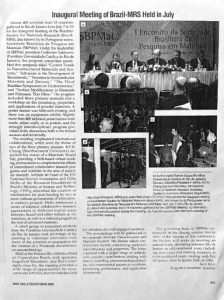
A year later, from July 7th to 10th 2002, almost 400 scientists, from 18 countries, gathered in Rio de Janeiro, at the Carlton Rio Atlantica Hotel and Convention Center, for the inaugural meeting of the Brazil MRS, with English as the official language. It is thus clear the international environment of the meeting. In fact, the foreign participants included the presidents of MRS (Alex King) and the European MRS, E-MRS (Giovani Marletta), as well as the General Secretary of the International Union of MRS, IUMRS, (Robert P. Chang). Chaired by the founding president Guillermo Solórzano (Catholic University of Rio de Janeiro), the program committee assembled five symposia ranging from nanostructured Materials and System to Semiconductors and polymeric thin film materials. The program included plenary sessions and a workshop on the processing of powder materials. Slightly more than 400 technical presentations were made either orally or as posters, displayed in a neighboring area of a commercial exhibition, engaging the attendees into lively discussions. The meeting emphasized international materials collaborations, which were the themes of three plenary sessions. RP Chang described his vision of a Materials World Net to complement efforts of international materials research collaborations; Adrian the Graff of the US National Science foundation, NSF, and Celso P. de Mello of Brazilian founding Agency, CNPq, described the creation of mechanisms for joint funding towards establishing , with other governmental agencies, an Inter-American Materials Collaboration Program. At the closing session the SBPMat governing body announced that, in view of the success of this conference, the society will make this meeting an annual event.
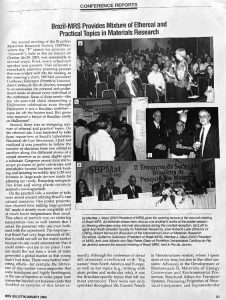 On October 26th-29th 2003 the second BMRS meeting took place also in Rio de Janeiro. The program, augmented to six symposia, covering a wider spectrum of subjects including on Nanostructured and Biomaterials II, Materials for energy conversion and environmental protection, Structural alloys for transport systems, composite and supramolecular materials, and a workshop on Semiconductors group III nitrides. High light of this meeting were two plenary sessions on international collaboration: one session in the scope of the Inter-American Collaboration Program –CIAM, with authorities of the Brazilian funding agencies CNPq and FINEP, the NSF and MRS president (also representing the US National Academy of Sciences). The event also hosted a Pan American Advanced study institute, funded by NSF, with the participation of students from Brazil, the US and other Latin American countries. The meeting also provided a commercial exhibition of products and services of interested to the community of materials researchers. With close to 500 participants and held at the Pestana Rio Atlantica Hotel Convention Center, on Copacabana beach with Rio other sights closed by, the meeting provided a wide range of opportunities for extra curriculum activities, but nevertheless held the attention of a well-engaged audience.
On October 26th-29th 2003 the second BMRS meeting took place also in Rio de Janeiro. The program, augmented to six symposia, covering a wider spectrum of subjects including on Nanostructured and Biomaterials II, Materials for energy conversion and environmental protection, Structural alloys for transport systems, composite and supramolecular materials, and a workshop on Semiconductors group III nitrides. High light of this meeting were two plenary sessions on international collaboration: one session in the scope of the Inter-American Collaboration Program –CIAM, with authorities of the Brazilian funding agencies CNPq and FINEP, the NSF and MRS president (also representing the US National Academy of Sciences). The event also hosted a Pan American Advanced study institute, funded by NSF, with the participation of students from Brazil, the US and other Latin American countries. The meeting also provided a commercial exhibition of products and services of interested to the community of materials researchers. With close to 500 participants and held at the Pestana Rio Atlantica Hotel Convention Center, on Copacabana beach with Rio other sights closed by, the meeting provided a wide range of opportunities for extra curriculum activities, but nevertheless held the attention of a well-engaged audience.
The proceedings of the 1st and 2nd Brazil MRS Meetings were published in two journals: Materials Characterization and Materials Research. The former selects contributions mainly concerning materials microstructure and properties. The later, a journal with a larger range of subjects, consider contributions dealing with theory, modeling, phenomenological studies and experimental papers on synthesis, processing, performance and applications of materials.
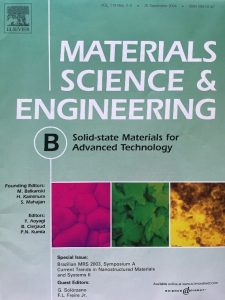 Brazil is country of continental dimensions with several options for venues to host BMRS meetings. An important defining criterion, however, is to offer an appropriate relaxing environment with hotels and convenient accommodation for students, local tourist attractions together with a ready access to an International airport. So the 3rd BMRS was held in world famous Iguassu Falls, south west of Brazil, from October 10th -13th 2004 at Hotel Bourbon Cataratas and Convention Center. The meeting consolidated the symposium model and the Program committee successfully organized a set of topics enhancing the interdisciplinary scope of materials research in 9 symposia, covering theory and frontiers on experimental research, from solid state chemistry to environmental sciences applied to materials. One workshop on Spintronics in Semiconductors was also included. Joining efforts with sister scientific societies and lead by Elson Longo (Federal University of Sao Carlos), BMRS president in this year, other well-stablished materials-related events were incorporated in this BMRS edition: the IV Brazilian Symposium on Electroceramics and a Symposium on Nano-scale structural Characterization of Materials, hosting the bi-annual MICROMAT meeting, which is a traditional event of the Brazilian Society for Microscopy and Microanalysis- SBMM. Three plenary lectures presented New Developments in Nanotechnologies (Cylon Gonçalves da Silva, General Secretary, Ministry of Science and Technology- MCT, Brazil), the Atomistic Structure of Internal Interfaces (Manfred Ruhle, director Max Plank Institut, Germany) and on International Cooperation on Nanotechnologies (Dietling Jering, The European Union). The number of registered participants at this 3rd Meeting was close to 1000.
Brazil is country of continental dimensions with several options for venues to host BMRS meetings. An important defining criterion, however, is to offer an appropriate relaxing environment with hotels and convenient accommodation for students, local tourist attractions together with a ready access to an International airport. So the 3rd BMRS was held in world famous Iguassu Falls, south west of Brazil, from October 10th -13th 2004 at Hotel Bourbon Cataratas and Convention Center. The meeting consolidated the symposium model and the Program committee successfully organized a set of topics enhancing the interdisciplinary scope of materials research in 9 symposia, covering theory and frontiers on experimental research, from solid state chemistry to environmental sciences applied to materials. One workshop on Spintronics in Semiconductors was also included. Joining efforts with sister scientific societies and lead by Elson Longo (Federal University of Sao Carlos), BMRS president in this year, other well-stablished materials-related events were incorporated in this BMRS edition: the IV Brazilian Symposium on Electroceramics and a Symposium on Nano-scale structural Characterization of Materials, hosting the bi-annual MICROMAT meeting, which is a traditional event of the Brazilian Society for Microscopy and Microanalysis- SBMM. Three plenary lectures presented New Developments in Nanotechnologies (Cylon Gonçalves da Silva, General Secretary, Ministry of Science and Technology- MCT, Brazil), the Atomistic Structure of Internal Interfaces (Manfred Ruhle, director Max Plank Institut, Germany) and on International Cooperation on Nanotechnologies (Dietling Jering, The European Union). The number of registered participants at this 3rd Meeting was close to 1000.
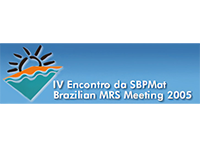 The 4th BMRS Meeting moved to Recife, an important and historical capital in the north east of Brazil, October 16th-19th 2005. The program committee, chaired by Celso P. de Mello and Anderson S.L. Gomes (Federal University of Pernambuco), successfully set up 8 symposia, all on interdisciplinary topics, including 37 invited talks by national and international scientists, 157 oral and 599 posters presentations, providing a total of 793 technical contributions, involving over 800 participants in the meeting. The opening session had as the Keynote Speaker Prof. Sérgio Rezende, the Brazilian Minister of Science and Technology, a world renowned materials scientist himself. Four Plenary Lectures were also delivered by international experts in different themes of materials research: Atomic-scale Defect Analysis of Ceramic Materials (Barry Carter – Department of Chemical Engineering and Materials Science University of Minnesota, US), Construction of Molecular Nano-Structures and Electronic Properties (Takuji Ogawa , Center for Molecular-Scale Nanoscience, Institute of Molecular Science, IMS/Okazaki, Japan), Multifunctional Organic/Inorganic Hybrids (Luis A. Ferreira M. Dias Carlos, Department of Physics, Universidade de Aveiro. Portugal), and from High-Temperature Superconductivity to Complex Electron Systems Science (H. Takagi, Magnetic Materials Laboratory, RIKEN’S Discovery Research Institute). A well-attended roundtable discussion session was included in this year’s program, aiming at stablishing the perspectives of the materials science area in Brazil. As in previous years, the meeting also offered a commercial exhibition.
The 4th BMRS Meeting moved to Recife, an important and historical capital in the north east of Brazil, October 16th-19th 2005. The program committee, chaired by Celso P. de Mello and Anderson S.L. Gomes (Federal University of Pernambuco), successfully set up 8 symposia, all on interdisciplinary topics, including 37 invited talks by national and international scientists, 157 oral and 599 posters presentations, providing a total of 793 technical contributions, involving over 800 participants in the meeting. The opening session had as the Keynote Speaker Prof. Sérgio Rezende, the Brazilian Minister of Science and Technology, a world renowned materials scientist himself. Four Plenary Lectures were also delivered by international experts in different themes of materials research: Atomic-scale Defect Analysis of Ceramic Materials (Barry Carter – Department of Chemical Engineering and Materials Science University of Minnesota, US), Construction of Molecular Nano-Structures and Electronic Properties (Takuji Ogawa , Center for Molecular-Scale Nanoscience, Institute of Molecular Science, IMS/Okazaki, Japan), Multifunctional Organic/Inorganic Hybrids (Luis A. Ferreira M. Dias Carlos, Department of Physics, Universidade de Aveiro. Portugal), and from High-Temperature Superconductivity to Complex Electron Systems Science (H. Takagi, Magnetic Materials Laboratory, RIKEN’S Discovery Research Institute). A well-attended roundtable discussion session was included in this year’s program, aiming at stablishing the perspectives of the materials science area in Brazil. As in previous years, the meeting also offered a commercial exhibition.
 The efforts to provide the society with a professional administration structure, initiated in 2006 with Fernando Lazaro F Jr (Catholica University of Rio de Janeiro) as president of BMRS, proved to be productive regarding the communication required for the organization of the following meetings. So the 5th BMRS Meeting was successfully held at Costao do Santinho Resort and Spa in Florianopolis, a city of spectacular natural scenarios in in the south of Brazil, October 8th-12th 2006. Under the coordination o Aloisio N Klein (Federal University of Santa Catarina, UFSC), the program reached 13 symposia. In parallel, a well-attended commercial exhibition stimulated the attendee’s interest on experimental materials research. This 5th edition was organized jointly with the MICROMAT meeting, contributing with 4 symposia to the event overall and enriching the 1scope of topics and the key note lectures, such as the one delivered by the president of the International Federation of Microscopy Societies –IFSM (Cristian Colliex, Orsay, France) . This meeting also hosted the International Symposium on Hybrid Materials, chaired by Antony Cheetham (University of Santa Barbara, US), and the 5th Brazilian Symposium on Electroceramics, chaired by R. Muccillo (IPEN, SP) and JA Varela (UNESP, SP) As a result, a record number of 1166 submitted abstracts and a about 1000 participants proved this annual meeting to constitute the most important Brazilian conference of Materials Science and Engineering.
The efforts to provide the society with a professional administration structure, initiated in 2006 with Fernando Lazaro F Jr (Catholica University of Rio de Janeiro) as president of BMRS, proved to be productive regarding the communication required for the organization of the following meetings. So the 5th BMRS Meeting was successfully held at Costao do Santinho Resort and Spa in Florianopolis, a city of spectacular natural scenarios in in the south of Brazil, October 8th-12th 2006. Under the coordination o Aloisio N Klein (Federal University of Santa Catarina, UFSC), the program reached 13 symposia. In parallel, a well-attended commercial exhibition stimulated the attendee’s interest on experimental materials research. This 5th edition was organized jointly with the MICROMAT meeting, contributing with 4 symposia to the event overall and enriching the 1scope of topics and the key note lectures, such as the one delivered by the president of the International Federation of Microscopy Societies –IFSM (Cristian Colliex, Orsay, France) . This meeting also hosted the International Symposium on Hybrid Materials, chaired by Antony Cheetham (University of Santa Barbara, US), and the 5th Brazilian Symposium on Electroceramics, chaired by R. Muccillo (IPEN, SP) and JA Varela (UNESP, SP) As a result, a record number of 1166 submitted abstracts and a about 1000 participants proved this annual meeting to constitute the most important Brazilian conference of Materials Science and Engineering.
 The following year, for the 6th edition, the meeting moved again to the North Easter region of Brazil, being held in the exuberant city of Natal at SERHS Grand Hotel and convention center, October 28th –November 1st 2007. Coordinated by Dulce M de Araujo (Federal University of Rio Grande do Norte- UFRN) the program consisted of plenary lectures and 10 symposia covering a wide range of topics, ranging from nanomaterials to superconductors, including organic semiconductors, multiferroic materials, catalysis, and computational modeling of materials. The meeting had 1057 submitted abstracts nearly reaching again one thousand participants, with significant numbers of delegates from abroad, namely form Latin America and Europe. The commercial exhibition has continued to increase in number of stands and gained the name of VI Expomat.
The following year, for the 6th edition, the meeting moved again to the North Easter region of Brazil, being held in the exuberant city of Natal at SERHS Grand Hotel and convention center, October 28th –November 1st 2007. Coordinated by Dulce M de Araujo (Federal University of Rio Grande do Norte- UFRN) the program consisted of plenary lectures and 10 symposia covering a wide range of topics, ranging from nanomaterials to superconductors, including organic semiconductors, multiferroic materials, catalysis, and computational modeling of materials. The meeting had 1057 submitted abstracts nearly reaching again one thousand participants, with significant numbers of delegates from abroad, namely form Latin America and Europe. The commercial exhibition has continued to increase in number of stands and gained the name of VI Expomat.
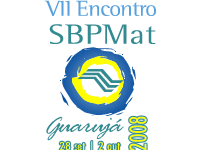 The seventh annual Meeting was held in Guaruja, a beach resort in the state of Sao Paulo, Southeast of Brazil, at Casa Grande Hotel Resort and Spa, Praia da Enseada, September 28th – October 2nd 2008. Chaired by Aldo Craievich (University of Sao Paulo-USP) and Reginaldo Muccillo (Institute for Nuclear Energy Research-IPEN) the program offered 8 plenary lectures delivered by outstanding scientists and successfully sat up 14 symposia, including 5 symposia in partnership with MICROMAT meeting, and one microscopy pre-meeting course. With a total of 1417 submitted abstracts, the meeting reached a record of 1284 registered participants including about 700 graduate and undergraduate students! Two MRS journalist covered this meeting in loco and reported it in a 2008 issue of the MRS Bulletin.
The seventh annual Meeting was held in Guaruja, a beach resort in the state of Sao Paulo, Southeast of Brazil, at Casa Grande Hotel Resort and Spa, Praia da Enseada, September 28th – October 2nd 2008. Chaired by Aldo Craievich (University of Sao Paulo-USP) and Reginaldo Muccillo (Institute for Nuclear Energy Research-IPEN) the program offered 8 plenary lectures delivered by outstanding scientists and successfully sat up 14 symposia, including 5 symposia in partnership with MICROMAT meeting, and one microscopy pre-meeting course. With a total of 1417 submitted abstracts, the meeting reached a record of 1284 registered participants including about 700 graduate and undergraduate students! Two MRS journalist covered this meeting in loco and reported it in a 2008 issue of the MRS Bulletin.
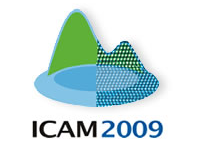 In 2009 Rio de Janeiro hosted the International Conference of Advanced Materials, ICAM 2009, for the first time in South America, with Guillermo Solórzano (Pontifical Catholic University of Rio de Janeiro, PUC-Rio) and Elisa B Saitovitch (Brazilian Center for Physics Research) as chairs. ICAM is the most prestigious conference of the International Union of Materials Research Societies (IUMRS) and in 2009 was organized together with the 8th Brazilian MRS Meeting from 20th to 25th September 2009. Twenty eighth technical symposia, 8 plenary lectures, 2 workshops, an Energy Forum and an Exhibition composed the program. Each symposium featured invited talks, contributed oral and poster presentations. About 2000 scientists from 47 countries gathered at Windsor Convention Center in Rio, during this event. The 28 Symposia were assembled in seven major areas: Nanoscience and Nanotechnologies, Health and Biological Materials, Energy and Environment, Functional and Electronic Materials, Structural Materials, Theory and Phenomena, and General Interest. The meeting opened with an official ceremony which included address talks by the president of the Brazilin MRS, the Program Committee Chair, the Conference Chairman and Brazilian government authorities. The state ministry for Science and Technology delivered the opening lecture. All the oral presentation were delivered in English, which emphasized the international flavor of the meeting. As in previous BMRS meetings, a poster session was held each evening and a there was also an equipment exhibition. More than 1800 technical presentations were made (485 orally and 1374 posters) and the strong interdisciplinary program provoked lively discussions both in the formal sessions and informally and in the formal session. The conference also featured two workshops “Innovation in Materials Research “and “Global Nanotechnology Network” and an Energy Forum. The commercial exhibition has doubled in terms of space and number of stands.
In 2009 Rio de Janeiro hosted the International Conference of Advanced Materials, ICAM 2009, for the first time in South America, with Guillermo Solórzano (Pontifical Catholic University of Rio de Janeiro, PUC-Rio) and Elisa B Saitovitch (Brazilian Center for Physics Research) as chairs. ICAM is the most prestigious conference of the International Union of Materials Research Societies (IUMRS) and in 2009 was organized together with the 8th Brazilian MRS Meeting from 20th to 25th September 2009. Twenty eighth technical symposia, 8 plenary lectures, 2 workshops, an Energy Forum and an Exhibition composed the program. Each symposium featured invited talks, contributed oral and poster presentations. About 2000 scientists from 47 countries gathered at Windsor Convention Center in Rio, during this event. The 28 Symposia were assembled in seven major areas: Nanoscience and Nanotechnologies, Health and Biological Materials, Energy and Environment, Functional and Electronic Materials, Structural Materials, Theory and Phenomena, and General Interest. The meeting opened with an official ceremony which included address talks by the president of the Brazilin MRS, the Program Committee Chair, the Conference Chairman and Brazilian government authorities. The state ministry for Science and Technology delivered the opening lecture. All the oral presentation were delivered in English, which emphasized the international flavor of the meeting. As in previous BMRS meetings, a poster session was held each evening and a there was also an equipment exhibition. More than 1800 technical presentations were made (485 orally and 1374 posters) and the strong interdisciplinary program provoked lively discussions both in the formal sessions and informally and in the formal session. The conference also featured two workshops “Innovation in Materials Research “and “Global Nanotechnology Network” and an Energy Forum. The commercial exhibition has doubled in terms of space and number of stands.
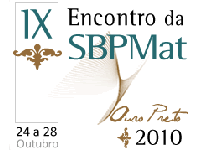 The BMRS entering its nine year of existence, the Brazilian materials research community was accustomed to the annual meeting. From 24th – 28th October 2010 the 9th BMRS meeting takes place in Minas Gerais, an important Brazilian central state, in Ouro Preto, a patrimonial city recognized by UNESCO, at UFOP Arts and Convention Center. Chaired by Margareth Spangler Andrade (Center for Technology of Minas Gerais , CETEC – MG) and Evando Mirra de Paula e Silva (Federal University of Minas Gerais UFMG/CGEE) the event offered an interdisciplinary program of 12 Symposia and 6 plenary lectures delivered by distinguish invited speakers. With a new record of 1766 submitted abstracts, 195 presentations were delivered orally and 1456 as posters, the meeting reached a 1562 registered participants, including graduate and undergraduate students!
The BMRS entering its nine year of existence, the Brazilian materials research community was accustomed to the annual meeting. From 24th – 28th October 2010 the 9th BMRS meeting takes place in Minas Gerais, an important Brazilian central state, in Ouro Preto, a patrimonial city recognized by UNESCO, at UFOP Arts and Convention Center. Chaired by Margareth Spangler Andrade (Center for Technology of Minas Gerais , CETEC – MG) and Evando Mirra de Paula e Silva (Federal University of Minas Gerais UFMG/CGEE) the event offered an interdisciplinary program of 12 Symposia and 6 plenary lectures delivered by distinguish invited speakers. With a new record of 1766 submitted abstracts, 195 presentations were delivered orally and 1456 as posters, the meeting reached a 1562 registered participants, including graduate and undergraduate students!
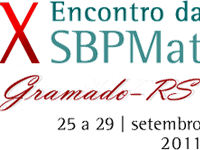 The 10th edition of the BMRS meeting was held in Gramado, an emblematic mountain region city in South of Brazil, at the Convection Center of Federal University of Rio Grande do Sul, October 25th- 29th 2011. The program and meeting committee chaired by Paulo F Fichtner and Naira M Balzaretti (Federal University of Rio Grande do Sul) arranged 16 symposia in a wellbalanced spectrum of subjects, 9 plenary lectures delivered by distinguished scientist from Brazil and abroad, and 3 pre-meeting courses on Advanced X ray diffraction techniques. Celebrating the occasion of the 10th meeting, BMRS president, Jose A Varela, inaugurated the “Joaquim da Costa Ribeiro Memorial Lecture” and presented an award in recognition for accomplishments serving the society to founding President Guillermo Solórzano and to former state ministry for Science and technology Sergio M Rezende. This year, numerical output continued to increase both in terms of submitted abstracts (1907) and presentations (266 oral and 1546 posters) with 1840 registered participants, stablishing a new record for a national meeting. The comercial exhibitions has become a well-established parallel event.
The 10th edition of the BMRS meeting was held in Gramado, an emblematic mountain region city in South of Brazil, at the Convection Center of Federal University of Rio Grande do Sul, October 25th- 29th 2011. The program and meeting committee chaired by Paulo F Fichtner and Naira M Balzaretti (Federal University of Rio Grande do Sul) arranged 16 symposia in a wellbalanced spectrum of subjects, 9 plenary lectures delivered by distinguished scientist from Brazil and abroad, and 3 pre-meeting courses on Advanced X ray diffraction techniques. Celebrating the occasion of the 10th meeting, BMRS president, Jose A Varela, inaugurated the “Joaquim da Costa Ribeiro Memorial Lecture” and presented an award in recognition for accomplishments serving the society to founding President Guillermo Solórzano and to former state ministry for Science and technology Sergio M Rezende. This year, numerical output continued to increase both in terms of submitted abstracts (1907) and presentations (266 oral and 1546 posters) with 1840 registered participants, stablishing a new record for a national meeting. The comercial exhibitions has become a well-established parallel event.
The BMRS meeting has then become a consolidated event in Brazil and known abroad. The symposium–base model has been successfully accepted by the local scientific community and gained increased attention. In the following years the meeting experienced a steady growth in the number of participants, as summarized in the paragraphs bellow, with no less than 20 and up to 40 different countries represented, mainly from Latin America and Europe. The meeting sites have moved year to year across the country, selected by the local arrangement committees. Highlights of the meetings are the continuous participation of renowned scientists as plenary and key note lectures on various state-of-the-art topics in Materials Science and Technologies. No less important has been the involvement of young students both in oral presentations and, more prominently, in the ebullient poster sessions. In fact, aiming at promoting and better organizing student’s participation, the Society successfully established University chapters. On the other hand, the comercial exhibitions has become a wellestablished parallel event.
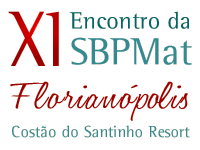 The 11th BMRS meeting was held again in Florianopolis, September 23th -27th 2012, at the same venue of 2006. The meeting was chaired by Aloisio N Klein and Adre A Pasa (Federal University of Santa Catarina) and program consisted of 16 Symposia, 7 plenary lectures and a round table discussion session on science technology and innovation in Brazil. BMRS President Roberto M Faria (University of São Paulo- USP) stablished in this meeting the Bernhard Gross Award. From the 1863 abstracts submitted to this meeting, 230 were presented orally and 1460 as posters with 1708 registered participants.
The 11th BMRS meeting was held again in Florianopolis, September 23th -27th 2012, at the same venue of 2006. The meeting was chaired by Aloisio N Klein and Adre A Pasa (Federal University of Santa Catarina) and program consisted of 16 Symposia, 7 plenary lectures and a round table discussion session on science technology and innovation in Brazil. BMRS President Roberto M Faria (University of São Paulo- USP) stablished in this meeting the Bernhard Gross Award. From the 1863 abstracts submitted to this meeting, 230 were presented orally and 1460 as posters with 1708 registered participants.
 The 12th BMR meeting moved to Campos to Jordão, a touristic mountain region city in Sao Paulo state, at the Convention center, September 29th- October 3rd 2013. The conference was chaired by José Alberto Giacometti (University of Sao Paulo, USP) and Julio R Sambrano (Faculty of Sciences, UNESP); and the program featured 16 symposia, an opening lecture, 7 plenary lectures, a round table discussion session on Science, Engineering of Industrial, Electronic and Biomedical Devices, a Humboldt Kolleg 2013 – Science & Technology in Contemporary Life: Impacts and Horizons and a “Bernhard Gross Award” Closing ceremony. The number of submitted abstract was 1835, of which 215 presented orally and 1547 as posters with 1679 registered participants.
The 12th BMR meeting moved to Campos to Jordão, a touristic mountain region city in Sao Paulo state, at the Convention center, September 29th- October 3rd 2013. The conference was chaired by José Alberto Giacometti (University of Sao Paulo, USP) and Julio R Sambrano (Faculty of Sciences, UNESP); and the program featured 16 symposia, an opening lecture, 7 plenary lectures, a round table discussion session on Science, Engineering of Industrial, Electronic and Biomedical Devices, a Humboldt Kolleg 2013 – Science & Technology in Contemporary Life: Impacts and Horizons and a “Bernhard Gross Award” Closing ceremony. The number of submitted abstract was 1835, of which 215 presented orally and 1547 as posters with 1679 registered participants.
On September 28- October 2 nd 2014, the 13th BMRS meeting moved back to Northeast Brazil, being held in the historical city of João Pessoa, and capital of Paraiba state, at the Convention Center. The meeting was chaired by Ieda M Garcia dos Santos (Department of Chemistry, Federal University of Paraiba, UFPB) and Severino J Guedes de Lima (Department of Mechanical Engineering, UFPB) and the program featured 19 symposia, including International Symposium Cementitious Materials (ICSM-2014), an opening lecture, 7 plenary lectures and the Bernhard Gross Award” Closing ceremony. The submitted posters reached the record number of 2528, enabling 294 oral presentations and 1800 as posters with 2148 register participants, including 1652 effective attendees.
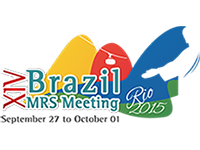 The 14th BMRS meeting was held again in Rio de Janeiro, at the Sul America Convention Center, September 27th – October 1st, 2015. The meeting chairs Marco Cremona (Department of Physics, PUC-Rio) and Fernando Lazaro F. Jr (Brazilian Center for Physics Research, CBPF) assembled a program of 27 symposia, an opening session/memorial lecture, 7 plenary lectures and 2 workshops, one on Nanofabrication and innovating manufacturing technologies and the other on Organic/Thin films Electronics in Industry and Processes, and a Closing ceremony awards presentation session. The 27 symposia were organized in 7 major groups: Nanomaterials and Synthesis, Theory Characterization and Modelling, Electronics and Photonics, Energy and Sustainability (which included the 8th International Summit on Organic and Hybrid Solar Cell Stability (ISOS-8), Biomaterials and Soft Materials, and New Horizons in Materials Science. A new record was established in terms of submitted abstracts: 1607 and in terms of presentations: 373 orally and 1880 as posters, with 1987 registered participants including 1400 attendees.
The 14th BMRS meeting was held again in Rio de Janeiro, at the Sul America Convention Center, September 27th – October 1st, 2015. The meeting chairs Marco Cremona (Department of Physics, PUC-Rio) and Fernando Lazaro F. Jr (Brazilian Center for Physics Research, CBPF) assembled a program of 27 symposia, an opening session/memorial lecture, 7 plenary lectures and 2 workshops, one on Nanofabrication and innovating manufacturing technologies and the other on Organic/Thin films Electronics in Industry and Processes, and a Closing ceremony awards presentation session. The 27 symposia were organized in 7 major groups: Nanomaterials and Synthesis, Theory Characterization and Modelling, Electronics and Photonics, Energy and Sustainability (which included the 8th International Summit on Organic and Hybrid Solar Cell Stability (ISOS-8), Biomaterials and Soft Materials, and New Horizons in Materials Science. A new record was established in terms of submitted abstracts: 1607 and in terms of presentations: 373 orally and 1880 as posters, with 1987 registered participants including 1400 attendees.
 In spite of the economic situation affecting Brazil since the last decade, BMRS president Oswaldo N de Oliveira Jr (University of Sao Paulo USP) and his team were successful in maintaining the impetus and quality of the society’s well- stablished activities. For the 15th Edition the BMRS annual meeting stayed in the South East of Brazil, in Campinas, a technological hub city in the state of Sao Paulo, 25th – 29th September 2016, at the Expo Dom Pedro Convention Center. Chaired by Ana Flavia Nogueira (Institute of Chemistry, Unicamp) and Monica A Cotta (institute of Physics, Unicamp) the meeting program features 23 symposia, an opening session/memorial lecture, 5 plenary lectures, 3 meeting panels, one workshops (school of scientists and hands on tutorial), and a Closing ceremony. From the 2133 abstract submitted, 276 were presented orally and 1567 as posters with 1768 registered participants and 1416 effectively attending.
In spite of the economic situation affecting Brazil since the last decade, BMRS president Oswaldo N de Oliveira Jr (University of Sao Paulo USP) and his team were successful in maintaining the impetus and quality of the society’s well- stablished activities. For the 15th Edition the BMRS annual meeting stayed in the South East of Brazil, in Campinas, a technological hub city in the state of Sao Paulo, 25th – 29th September 2016, at the Expo Dom Pedro Convention Center. Chaired by Ana Flavia Nogueira (Institute of Chemistry, Unicamp) and Monica A Cotta (institute of Physics, Unicamp) the meeting program features 23 symposia, an opening session/memorial lecture, 5 plenary lectures, 3 meeting panels, one workshops (school of scientists and hands on tutorial), and a Closing ceremony. From the 2133 abstract submitted, 276 were presented orally and 1567 as posters with 1768 registered participants and 1416 effectively attending.
 The 16th BMRS meeting moved again to Gramado, at FAURGS, September 10th – 14th 2017, chaired by Daniel E Weibel (Federal University of Rio Grande do Sul- UFRGS). Keeping up with the previous meetings, this edition programmed 23 symposia, one workshop (Young researches school: how to produce and publish high impact papers), an opening ceremony/memorial lecture and a closing ceremony. From the 2029 abstract submitted, 345 were presented orally and 1487 as posters with 1507 registered participants and 1275 attendees form about 20 countries.
The 16th BMRS meeting moved again to Gramado, at FAURGS, September 10th – 14th 2017, chaired by Daniel E Weibel (Federal University of Rio Grande do Sul- UFRGS). Keeping up with the previous meetings, this edition programmed 23 symposia, one workshop (Young researches school: how to produce and publish high impact papers), an opening ceremony/memorial lecture and a closing ceremony. From the 2029 abstract submitted, 345 were presented orally and 1487 as posters with 1507 registered participants and 1275 attendees form about 20 countries.
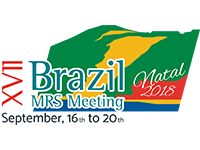 As venue for the 17th BMRS meeting the city of Natal in the northeast Brazil was chosen for the second time. The event took place at the Praiamar Natal Hotel and convention center, September 10th -14th 2018. Chaired by Antonio E Martinelli (Federal University of Rio Grande do Norte) the meeting featured 21 symposia, one workshop (reedition of the successful Young researchers’ school), an opening ceremony/memorial lecture, 8 plenary lectures and the closing ceremony. From the 1743 abstract submitted, 343 were presented orally and 1256 as posters with 1861 registered participants and 1071 effective attendees.
As venue for the 17th BMRS meeting the city of Natal in the northeast Brazil was chosen for the second time. The event took place at the Praiamar Natal Hotel and convention center, September 10th -14th 2018. Chaired by Antonio E Martinelli (Federal University of Rio Grande do Norte) the meeting featured 21 symposia, one workshop (reedition of the successful Young researchers’ school), an opening ceremony/memorial lecture, 8 plenary lectures and the closing ceremony. From the 1743 abstract submitted, 343 were presented orally and 1256 as posters with 1861 registered participants and 1071 effective attendees.
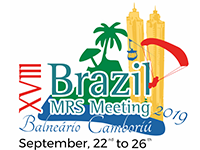 The 18th annual Meeting was held in Camburiu, a beach resort city in the southern state of Santa Catarina, September 22th – 28th 2019. The meeting, chaired by Ivan H Bechtold (Department of Physics, Federal University of Santa Catarina–UFSC) and Hugo Gallardo (Department of Chemistry, UFSC) assembled a program constituted of 23 symposia, an opening ceremony/memorial lecture, 8 plenary lectures, a pre-meeting workshop and the closing ceremony. The 23 Symposia were organized in 5 major groups: Bio-related Materials and Applications, Materials Properties and Emerging Technologies, Materials Characterization and Degradation, Materials Synthesis and Processing, Nanostructured and Functional materials. The number of submitted abstracts stablished a new record of 2616 as well as the 467 oral presentations and 1868 posters, with 1987 register participants including 1686 attendees.
The 18th annual Meeting was held in Camburiu, a beach resort city in the southern state of Santa Catarina, September 22th – 28th 2019. The meeting, chaired by Ivan H Bechtold (Department of Physics, Federal University of Santa Catarina–UFSC) and Hugo Gallardo (Department of Chemistry, UFSC) assembled a program constituted of 23 symposia, an opening ceremony/memorial lecture, 8 plenary lectures, a pre-meeting workshop and the closing ceremony. The 23 Symposia were organized in 5 major groups: Bio-related Materials and Applications, Materials Properties and Emerging Technologies, Materials Characterization and Degradation, Materials Synthesis and Processing, Nanostructured and Functional materials. The number of submitted abstracts stablished a new record of 2616 as well as the 467 oral presentations and 1868 posters, with 1987 register participants including 1686 attendees.
 The 19th BMRS meeting, planned to be held in Foz de Iguazu in 2020, did not take place because of the pandemic year. So it was postponed and held virtually from August 30th to September 3rd 2021 together with the 2021 International Conference on Electronic Materials – IUMRS ICEM 2021. The meeting chairs Gustavo M Dalpian (Federal University of ABC) and Carlos C B Bufon (National Nanotechnology Laboratory) were successful in setting up a full program consisting on 23 symposia, an opening ceremony /memorial lecture, 9 plenary lectures and a Closing ng ceremony awards presentation, besides a pre-meeting school (Young researchers), a workshop (Women in Science) and a parallel virtual exhibition. In addition, a discussion on CBAN- BrazilArgentina Nanotechnology Center was stablished. From the 1003 abstract submitted, 304 were presented orally and 706 as posters with 1307 registered participants including 1038 effective attendees.
The 19th BMRS meeting, planned to be held in Foz de Iguazu in 2020, did not take place because of the pandemic year. So it was postponed and held virtually from August 30th to September 3rd 2021 together with the 2021 International Conference on Electronic Materials – IUMRS ICEM 2021. The meeting chairs Gustavo M Dalpian (Federal University of ABC) and Carlos C B Bufon (National Nanotechnology Laboratory) were successful in setting up a full program consisting on 23 symposia, an opening ceremony /memorial lecture, 9 plenary lectures and a Closing ng ceremony awards presentation, besides a pre-meeting school (Young researchers), a workshop (Women in Science) and a parallel virtual exhibition. In addition, a discussion on CBAN- BrazilArgentina Nanotechnology Center was stablished. From the 1003 abstract submitted, 304 were presented orally and 706 as posters with 1307 registered participants including 1038 effective attendees.
In summary, over the past two decades the Brazilian MRS meeting has grown steadily and consolidated as the major interdisciplinary meeting of Materials Science, Technology and Engineering in Brazil. It has reach a reputation that transcends country borders, is continuously attracting international participation, mainly from Latin America, USA and European countries, consolidated as the second Materials Research Meeting in the Americas and perhaps as number 3 in the western hemisphere. The merit of this success is due to the enthusiastic involvement of volunteer society members led by competent and dedicated Brazil MRS executives, with the effective assistance of a small and committed BMRS staff and the electronic and data processing Aptor system, over the years. The continuous support of (older) sister societies MRS and E-MRS as well of IUMRS have provided additional incentive. Recognition for the financial support received periodically from the Federal funding agencies MCT, CNPq, FINEP and CAPES, as well as from the State funding agencies namely FAPESP and FAPERJ for financing part of the infrastructure and granting the students participation. Other state agencies such as FAPEMIG, FAPERGS, and FAPESC have also contributed to local arrangements in their states. On the other hand, the partnership established with the commercial exhibitors, in enriching the success of the meetings, is also acknowledged.
Guillermo Solórzano
Brazilian MRS founding President
Rio de Janeiro, February 2022
This text was published as the following book chapter:
SOLORZANO, Guillermo. History of the Brazilian MRS Meetings. In: CREASE, Robert P. (Ed.). Between Science and Industry. Volume 3 of A World Scientific Encyclopedia of the Development and History of Materials Science. Hackensack: World Scientific, 2024. p. 415-426. DOI: https://doi.org/10.1142/13625.
B-MRS Newsletter. Year 10, issue 7.
|
||||||||||||||||||||||||||||||||||||||||
|
||||||||||||||||||||||||||||||||||||||||
|
(Português) Edital SBPMat – Programa University Chapters (UCs) 2023: Materiais e Desenvolvimento Sustentável.
B-MRS Newsletter. Year 10, issue 6.
|
||||||||||||||||||||||
|
||||||||||||||||||||||
|
Featured paper: Hydrating perovskites for a dimensional conversion.

Perovskites are very promising semiconductor materials for use in solar cells and other optoelectronic devices, but they have a limitation that impairs the useful life of their applications, their low stability. In this context, humidity can be considered the enemy of perovskites, as it is one of the main factors that accelerate the degradation of these materials.
Now, a discovery by researchers from the Brazilian Federal University of ABC (UFABC) brings a very different perspective on the interaction of water with perovskites. With a process based on the simple hydration of three-dimensional perovskite structures, the scientists were able to generate two-dimensional (sheet) and one-dimensional (wire) structures, which, in addition to being more stable than 3D structures, have different properties.
“In controlled amounts, the presence of water can be extremely beneficial for the synthesis of new structures in perovskites”, says André L. M. Freitas, postdoctoral fellow and author, together with Prof. José A. Souza, of the paper that reports this work in the Journal of Materials Chemistry C.
The authors produced micrometric cubes of MAPbBr3, a hybrid material (organic – inorganic) from the perovskite family, which is usually used in the academic environment in solar cells and LEDs. In this material, the inorganic part forms an octahedron, where the central atom (Pb) is surrounded by six halides (Br). “The octahedrons are extremely important in these materials, as they are directly responsible for the physical properties of the material”, explains the postdoc.
To generate the wires, the microcubes were placed in water. To produce the sheets, an organic molecule was added to water. In contact with the liquid, almost instantly, the material lost its crystalline structure, forming what the UFABC duo called an intermediate phase. “We faced a great challenge when analyzing this phase, as the process occurs quickly and many times we had to repeat the experiments to properly characterize it”, says Freitas.
Subsequently, when subjecting the material to drying, the water molecules were expelled from the structure and an interesting conversion took place: the material once again had a perovskite structure, but with a morphology and dimension different from the original ones. “That was one of our main contributions; we were able to control the recrystallization process and obtain different structures and dimensions”, says Freitas.
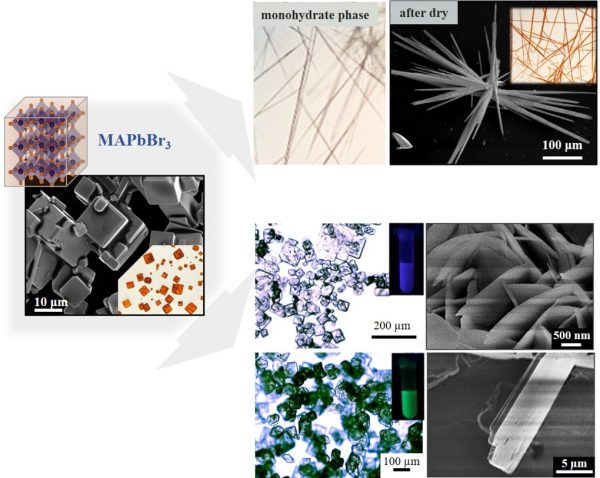
In the formation of the wires, the process inhibited the growth of the crystalline structure in two directions. In the case of the sheets, the organic molecule added to the water acted as a barrier to the growth of the material in one direction, as if it was a spacer between the layers of octahedra, giving rise to a new structure of the 2D perovskite family. Especially in the 2D structures, this confinement, which occurred on a very small scale, restricted the movement of electrons, resulting in very pronounced quantum effects which modified the electrical and optical properties of the material.
“Our observation revealed that dissolved or degraded material can recrystallize into interesting structures”, summarizes Freitas. According to the authors, by exploring the hydration process of perovskites, the work brings new perspectives to advance the understanding of the degradation and recrystallization of these materials, as well as to understand optical properties such as those involving the dynamics of the exciton (the electron – hole pair generated from the excitation of light in the semiconductor).
The work presents a simple, scalable and sustainable process to produce low-dimensional perovskites with controlled properties. The results could impact both application development and the study of the fundamentals of these versatile materials.
The research received financial support from Brazilian agencies FAPESP and CNPq.
Scientific paper reference: Water-induced dimensionality conversion from 3D perovskites to microwires and 2D hybrid halide perovskites. Andre L. M. Freitas and Jose A. Souza. J. Mater. chem. C, 2023, 11, 6651. https://doi.org/10.1039/D3TC00593C.
Authors contact: joseantonio.souza@ufabc.edu.br, andre_luizmf@yahoo.com.br.
B-MRS Newsletter. Year 10, issue 5.
|
||||||||||||||||||||||||||||||||
|
||||||||||||||||||||||||||||||||
|

